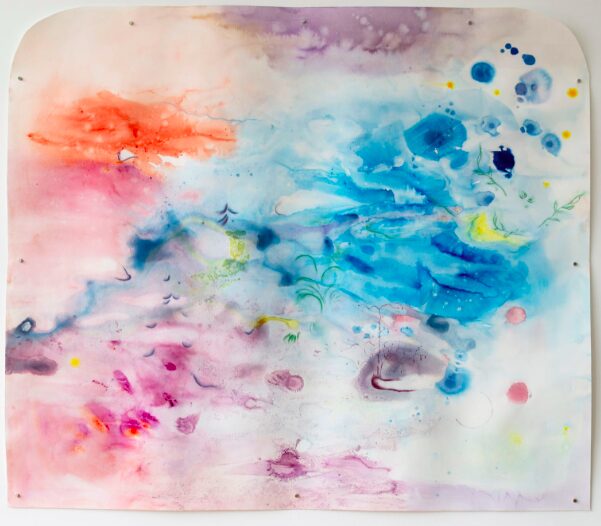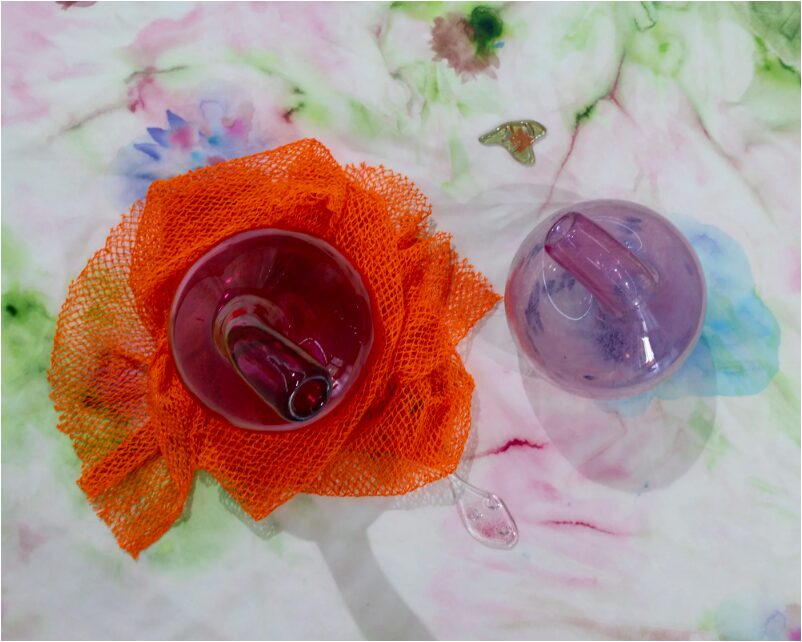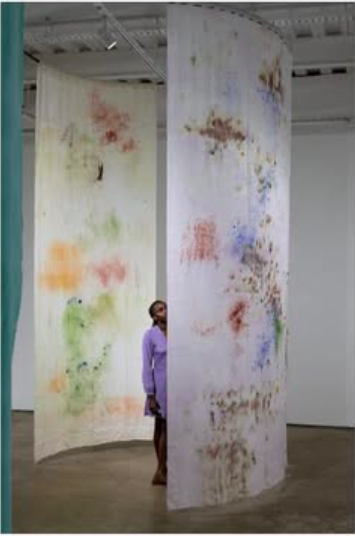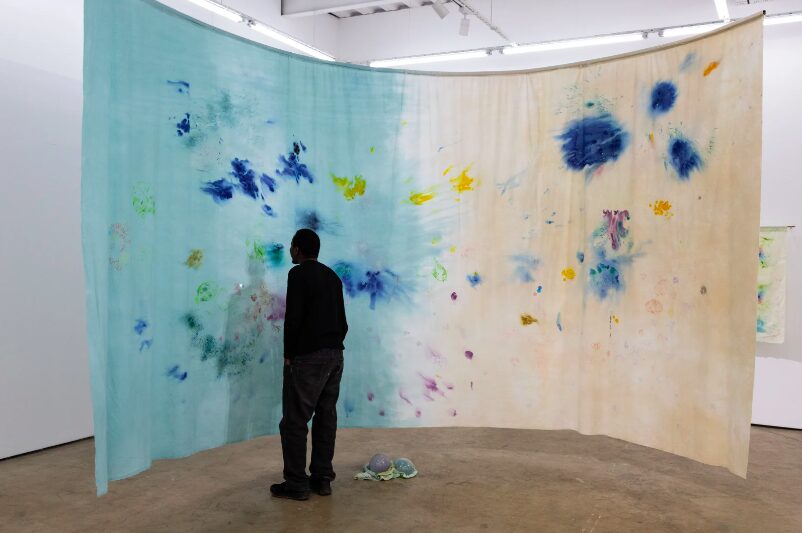Agnes Waruguru (b. 1994) is a Nairobi-born artist whose work has been shown internationally, including at the 2024 Venice Biennale – a particular achievement at such a young age. She studied at the Savannah College of Art (USA) and has been invited to several residencies both internationally and at home in Kenya. Her work is currently showing at Circle Art Gallery until 3 January.
Waruguru’s current body of work is delicate and ethereal. Water feels very important to the works – the pieces embody a flow and it’s difficult to capture a centre visually as your eyes trace the spills of colour. The works are produced by techniques of dyeing and pouring as well as brushwork, and they take the viewer into soft, subtly coloured visual landscape stories across both paper and cotton cloth. Waruguru says that:
“thinking about water…it’s something I’m really trying to catch all the time”
Waruguru also incorporates beadwork, sewing, needlework, embroidery and knitting into her artworks, connecting aspects of her personal identity to traditions of women’s work learned from the women in her life, passed along matrilineal lines.
In a conversation with Rosie Olang at Circle Gallery, Waruguru spoke thoughtfully about her work and processes.
Working across a variety of media, Waruguru explained, is “going back to the genesis of ideas…everything starts with the idea or the need to express something” From there she figures out the most efficient and best way to make that into a reality. She said that she is open to learning new ways of making all the time, because the idea dictates how the work will be best translated visually.

Facing Sky, 2024. Acrylic ink, watercolour and soft pastel on watercolour paper
Olang asked Waruguru to talk about water being thematic in the work, but also how it is very much a substrate in how the work is made.
Waruguru really unpacked and explored the numerous ways that water interplays with our lives, and hers in particular. She said she feels like she really started paying attention to water as a theme when she was in the Netherlands [for an art residency]
because it was such a huge part of my life… through the canals, that constant rain, being quite close to the sea…I just really started to see how alive and present water was.”
She then recalled early memories of being at her grandmother’s farm where collecting water and watering things was such a big part of the routine.
Waruguru iterates that water is, of course, a vital part of everybody’s life, and in this moment, thinking about climate change, it’s such a present force in all our lives. In this way, water connects us. At the same time she was thinking about the fact that we travel so much and move through space so much, and the history that is held in these kinds of transient spaces.
In another facet, “the salt water came from interacting with the sea, thinking about what information the sea has to give us, how many bodies have passed through there, or have been buried there, and what information is there that, and how do we access it? “
[Water] can be something that’s really heavy and brutal, catastrophic, but something that can also be quite cleansing…life giving…”
Waruguru’s affinity with water continues into her methodology, as she feels that a lot of her work remains in flux, with an opportunity for it to continue to extend itself without changing its sensibility.

Glasswork elements in Waruguru’s work
Waruguru talked about how she has explored glassworks as a means to “catch” the water as glass shares many properties with water: the way that it relates to light, the way that it can hold something, the transparency and especially the way the colours change. Like water, the color of glass changes depending on location and time of day.
Intertwined with the themes around water, Waruguru’s work is “focussing on lived experience in the world, reflecting on interactions with the earth, connecting this with the inner self”. The elements of her materials are as important as the markmaking in her work. She uses natural pigments, rainwater and salt water in a responsive process, working without a plan toward works that are a culmination of experimentation.
Pigments she uses are often related to lived experiences and memory keeping, for example, the use of hibiscus comes from sharing tea with friends and spilled tea on the tablecloth.

Saudade, 2024: Hibiscus flowers, urucung , tumeric, various flowers, fishing nets salty water on linen
Similarly, objects are related to living. For example, her work “Saudade” incorporates a fishing net, which was gifted to her at the site where she was making the work, a place that had suffered a landslide and the devastation that comes with it. Waruguru was going to the sea and hearing from the fishermen about how natural elements such as the tide and the landscape had changed dramatically.
Thus the incorporation of the nets gives them another life and carries the memory of the place. Seedpods collected from around Waruguru’s studio localize the work for her and show connections between different places.
Despite their diaphanous appearance, Waruguru’s works are process heavy. She collects seeds, flowers, such as hibiscus, and mineral pigments from rocks, largely on walks through the forest. First the fabric needs to be cleaned, by hand wash, then soaked with salt. Next she lays the fabric out in the studio and makes a composition with the pigments, after which it needs to be soaked again in a mordant for two days, to fix the natural colors onto the textile. When the piece is opened up, the result is a surprise.
Waruguru says that in this process she makes a lot of mistakes, which is good because things happen that she couldn’t have purposed, which in itself is a learning process and part of the flux of her work.
She prepares herself inwardly for these visual journeys via meditational preparation for working, by sweeping, laying out cloth & paper and boiling pigments in a sufriya.

Waruguru wishes to share the feeling in relation to the works that she gets in creating them. She tries to do this by scaling up the size of the work, and hanging it installation-style, as in “Saudade”, so people could be inside it, feel part of it, be close to it and feel embraced by the work. While making, she envisaged seeing people walking through the work and seeing people’s feet showing under it as they were on the other side. She interrogates the elements of the show as they would be together,
thinking about how they could move around, seeing how they react to light, how the show changes throughout the day”
Waruguru says that throughout her works, she trying to utilize space in the best way and make it welcoming, create a sense of intimacy and a sense of curiosity.
There are only a few days left to experience Waruguru’s colourful vision and experience her sense of exploration and curiosity in these light filled exploratory works.
Circle Art Gallery will be open from 11am – 4pm on 2 & 3 January. “What the Water Left Behind” closes on 3 January.
All images by Agnes Waruguru, courtesy of Circle Art Gallery
Circle Art Gallery, Victoria Square, Riara Rd., Lavington. @circleartagency


